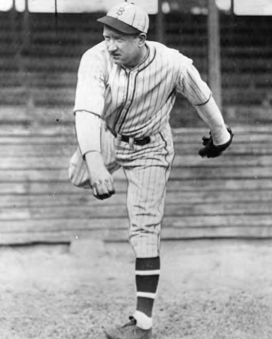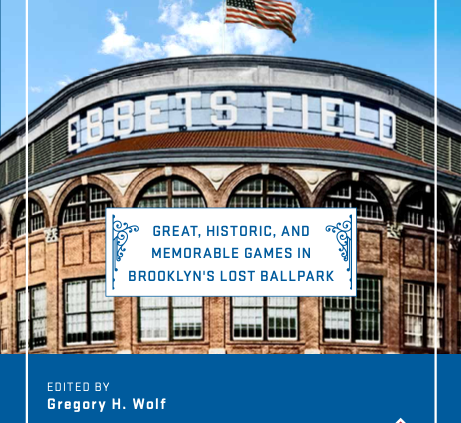July 20, 1925: Dodgers’ Dazzy Vance ties NL record with 17 strikeouts
 Hard-throwing Dazzy Vance was in agony. Brooklyn sportswriter Thomas W. Meany reported that Vance suffered from serious inflammation in his right shoulder caused by warming up too quickly six days earlier against the Pittsburgh Pirates.1 According to Robins beat reporter Thomas S. Rice, Vance’s right arm was “blue from the rupturing of a blood vessel,” which gave rise to rumors that the reigning National League MVP might be lost for an extended period.2 Shrugging off the stinging pain, Vance surprisingly took the mound and “reached the very pinnacle of his brilliant career,” gushed the Brooklyn Standard Union, in a heroic performance that “approache[d] closely the limit of human achievement.”3
Hard-throwing Dazzy Vance was in agony. Brooklyn sportswriter Thomas W. Meany reported that Vance suffered from serious inflammation in his right shoulder caused by warming up too quickly six days earlier against the Pittsburgh Pirates.1 According to Robins beat reporter Thomas S. Rice, Vance’s right arm was “blue from the rupturing of a blood vessel,” which gave rise to rumors that the reigning National League MVP might be lost for an extended period.2 Shrugging off the stinging pain, Vance surprisingly took the mound and “reached the very pinnacle of his brilliant career,” gushed the Brooklyn Standard Union, in a heroic performance that “approache[d] closely the limit of human achievement.”3
Vance’s courageous hurling occurred at an opportune time for the Robins, who were one of the majors’ biggest disappointments this far in the 1925 season. Following their surprise second-place finish in 1924, the Robins had got out to a fast start in ‘25, but had since lost 24 of their last 39 games to fall to 42-43, though they occupied fourth place. The rubber match of a three-game series against the St. Louis Cardinals as part of a 21-game homestand also marked the return to the dugout of beloved skipper Wilbert Robinson, the club’s namesake. According to the Brooklyn Eagle, the 61-year-old manager had turned over the day-to-day “management” of the team to star player Zack Wheat in mid-June and spent most of his time in the press box.4 “[I returned] merely to cheer up the team,” said Uncle Robbie. “We have had darned hard luck.”5
Robinson called on his ailing ace to get the team back to .500. A 34-year-old pitching marvel, Vance laid claim as the NL’s best hurler. After cups of coffee in 1915 and 1918, Vance caught on with the Robins in 1922 and had posted a 64-33 slate in his first three seasons with the club. In 1924, he won the pitching Triple Crown, leading the league with 28 wins, a 2.16 ERA, and 262 strikeouts, the third of seven consecutive seasons in which he led the NL in punchouts. He was 12-6 and paced the majors with 120 strikeouts thus far in ‘25, but had been pummeled in his last start, yielding 11 hits and eight runs (six earned) in just four innings in a loss to the Pirates. More troubling was Vance’s aching right shoulder. Should Vance not be able to pitch after warming up, reported the Standard Union, swingman Tiny Osborne would take his place.6
On a warm, 80-degree Tuesday afternoon, 3,500 spectators were on hand at Ebbets Field for the 3:30 start time against the St. Louis Cardinals.7 A half-game behind the Robins, the fifth-place Redbirds (42-44) had taken the first two games of the series.
Looking wobbly as the game commenced, Vance walked the first two batters. It was an ideal situation for the league’s most potent one-two punch, Rogers Hornsby, batting .413 and slugging .777, and Jim Bottomley, who checked in at .374 and .623. The Rajah, who had taken over for Branch Rickey as manger just a month earlier, fanned swinging, then Sunny Jim looked at a called strike. Vance dispatched Chick Hafey on an outfield fly to end the threat.
Toeing the rubber for the Cardinals was 30-year-old journeyman southpaw Duster Mails. Back in the majors after a two-year stint winning 47 combined games for Oakland Oaks in the Pacific Coast League, Mails had pitched briefly for the Robins in 1915 and 1916. Just three days earlier, Mails had tossed a four-hitter to beat the New York Giants, even his record at 2-2, and improve his career slate to 27-19. After leadoff hitter Hod Ford walked, Milt Stock reached base on Mails’ throwing error to second base. Wheat grounded into a 5-3 double play and Jack Fournier popped up to kill the rally.
Vance had fanned two batters in each of the first three innings but got into another jam in the fourth. Bottomley and Hafey connected for consecutive singles to short right field with no outs. After Specs Toporcer bunted the runners over, Les Bell drove them in on a single to center. Vance seemed to be on the ropes, but got some help from his batterymate, Hank DeBerry, who threw out Bell attempting to steal before Bob O’Farrell walked. Mails fanned looking for the third out.
Eddie Brown led off the fifth with the Robins’ second hit of the game. After Brown was forced by DeBerry’s one-out grounder, weak-hitting Vance (5 hits in 58 at-bats) pounded a home run into deep left field to tie the game, 2-2.
In an exciting pitchers’ duel, both pitchers mowed down their opponents. “[Mails’] curve and change of pace were corkers and he had all the speed,” opined Rice.8
Vance continued to pile up the strikeouts, the product of “uncanny pitching, which came as a result of tremendous speed and a lightning curve,” St. Louis sportswriter Martin J. Haley wrote admiringly.9 Vance fanned two in the seventh, then struck out the side in the eighth, pushing his total to 14, while also yielding hits to Max Flack and Hornsby. Vance mesmerized the high-powered Redbirds with a “bewildering assortment of hooks and benders in addition to his ‘sway-back’ fast ball,” exclaimed Meany.10
A brouhaha erupted in the eighth after Vance led off with a single and was forced by Ford. Former Cardinal Milt Stock doubled down the left-field line. Just as Ford rounded third, Hafey fumbled the ball, according to Haley.11 Hafey whipped the ball to Toporcer at short, who threw home. Catcher Bob O’Farrell courageously “threw down his hand to meet the crushing spikes” of Ford, wrote Cardinals beat reporter J. Roy Stockton.12 “O’Farrell had the ball before Ford started his final desperate leap,” opined Stockton, but umpire Peter McLaughlin called Ford safe.13 The Cardinals erupted in protest, but to no avail. “[T]he decision at the plate looked very bad,” admitted Rice,14 while Robinson supposedly told Hornsby the same thing after the game.15
The Cardinals tied the game in the top of the ninth on Toporcer’s leadoff triple and Bell’s single. After Mails executed a two-out sacrifice bunt, Vance intentionally walked Max Flack, who had already collected two hits and drawn a free pass. That strategy worked when Ralph Shinners popped up to second.
The game went into extra innings when Mails set down the Robins one-two-three in the ninth.
Vance began the 10th by fanning Hornsby and Bottomley for the third time each to increase his strikeout total to 17. Hafey gave the Redbirds a glimmer of hope by singling and stealing second. Unperturbed by baserunners, Vance repeated the same strategy from an inning earlier and walked Toporcer on Robinson’s order, despite bringing the more dangerous hitter Bell to the plate. Bell, who had knocked in all three Cardinals runs, popped up to second baseman Stock.
DeBerry led off the bottom of the 10th with a double and was replaced by pinch-runner Johnny Mitchell. After two unsuccessful attempts to execute a sacrifice bunt, Vance connected for his third hit of the game, a solid single to center that easily drove in Mitchell for the winning run, ending the game in 2 hours and 10 minutes.
Newspapers around the country raved about Vance’s strikeout total. He punched out a batter in every inning and two in an inning five times, including fanning the side in the eighth. Of his 17 strikeouts, 6 were looking and 11 swinging.16 Vance fanned every Cardinals starter except the bespectacled Toporcer, who “sees as through a pair of glasses, darkly,” quipped sportswriter James M. Gould.17 Vance permitted 15 baserunners, including nine hits. By contrast, Mails allowed nine baserunners, including one walk.
Vance’s 17 strikeouts equaled the mark set by the Chicago Cubs’ Jack Pfiester in a 15-inning complete-game loss, 4-2, to the Cardinals in the first game of a doubleheader on May 30, 1906. Charles Sweeney of the NL Providence Grays fanned 19 in 1884 when the distance from the front of pitcher’s box to home plate was 50 feet. Jack Coombs of the Philadelphia Athletics held the modern record. He fanned 18 twice: on September 1, 1906 in a 24-inning, 4-1 complete-game victory against the Boston Americans and then in a 16-inning 0-0 tie with Big Ed Walsh and the Chicago White Sox on August 4, 1910. The Cardinals’ Dizzy Dean matched Vance’s record in a nine-inning, 8-2 complete-game victory in the first game of a doubleheader over the Cubs on July 30, 1933. Pfiester, Vance, and Dean co-owned the NL record until the Boston Braves’ Warren Spahn punched out 18 in a 15-inning complete-game loss to the Cubs on June 14, 1952.
Vance’s dominance was even more impressive given the context of pitching in his era. In 1925 big-league teams averaged only 2.8 strikeouts per game compared with 8.9 in 2019. For the entire 1925 season, a pitcher recorded 10 or more strikeouts in game only 10 times (including once in the World Series), and more than 10 only twice. Vance recorded four of those games. The first three came in three consecutive starts in May when he whiffed 10, 10, and 13.
Vance finished the season as the NL leader in wins (22) and strikeouts (221) while the Robins slumped to sixth place (68-85).
SOURCES
In addition to the sources cited in the Notes, the author accessed Retrosheet.org, Baseball-Reference.com, SABR.org, and The Sporting News archive via Paper of Record.
Photo credit: Dazzy Vance, National Baseball Hall of Fame Library.
NOTES
1 Thomas W. Meany, “Vance’s Strikeout Records, Under Present Pitching Rules, Remarkable,” Brooklyn Times, July 21, 1925: 14.
2 Thomas S. Rice, “Vance Whiffing of 17 in 10 Innings Best Stunt in Modern Times,” Brooklyn Eagle, July 21, 1925: 2A.
3 “‘Dazzy’ Vance Reaches Pinnacle in Career in Striking Out Seventeen,” Brooklyn Standard Union, July 21, 1925: 14.
4 Thomas S. Rice, “Uncle Robbie Goes Back to Bench and Will Shake Up Batting Order,” Brooklyn Eagle, July 20, 1925: 2A.
5 “Uncle Robbie Goes Back to Bench and Will Shake Up Batting Order.”
6 “Southpaw Twirling Again Proves Puzzle to Robins – Lose Third Straight,” Brooklyn Standard Union, July 20, 1925: 10.
7 “The Weather,” Brooklyn Standard Union, July 21, 1925: 18.
8 Thomas S. Rice, “Vance Whiffing of 17 in 10 Innings Best Stunt in Modern Times.”
9 Martin J. Haley, “Vance Whiffs 17 Cardinals as Robins Take 10-Inning Game, 4-3,” St. Louis Globe-Democrat, July 21, 1925: 11.
10 Meany.
11 Haley.
12 J. Roy Stockton, “Vance Fans 17, Drives In 3 Out of 4 Runs to Beat Cardinals,” St. Louis Post-Dispatch, July 21, 1925: 9.
13 Stockton.
14 Thomas S. Rice, “Vance Whiffing of 17 in 10 Innings Best Stunt in Modern Times.”
15 Stockton.
16 Haley.
17 James M. Gould, “Rogers Hornsby and Bottomley Strike Out Three Times,” St. Louis Star and Times, July 21, 1925: 10.
Additional Stats
Brooklyn Robins 4
St. Louis Cardinals 3
10 innings
Ebbets Field
Brooklyn, NY
Box Score + PBP:
Corrections? Additions?
If you can help us improve this game story, contact us.


